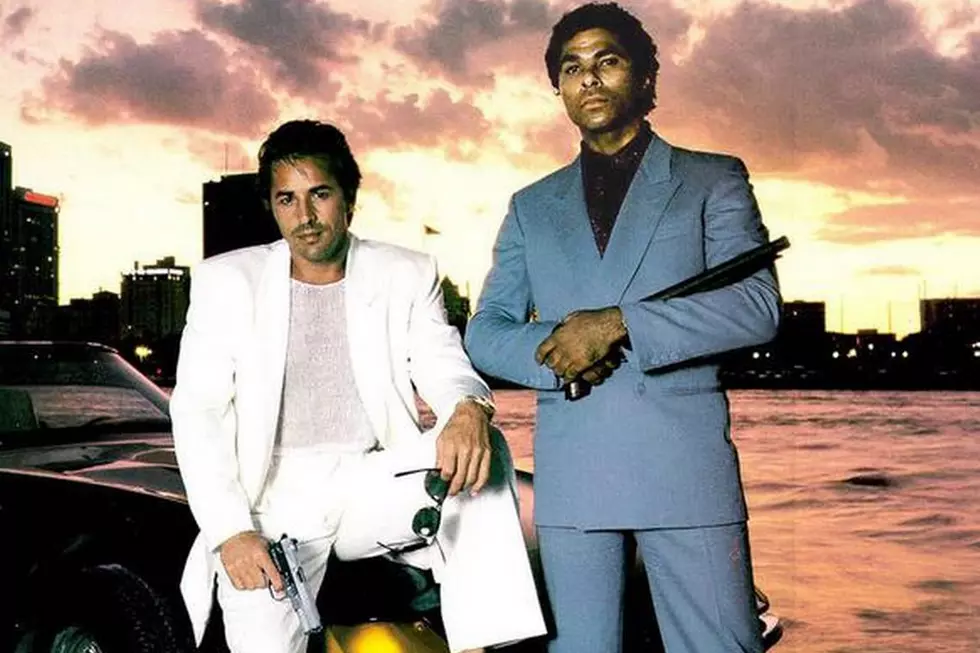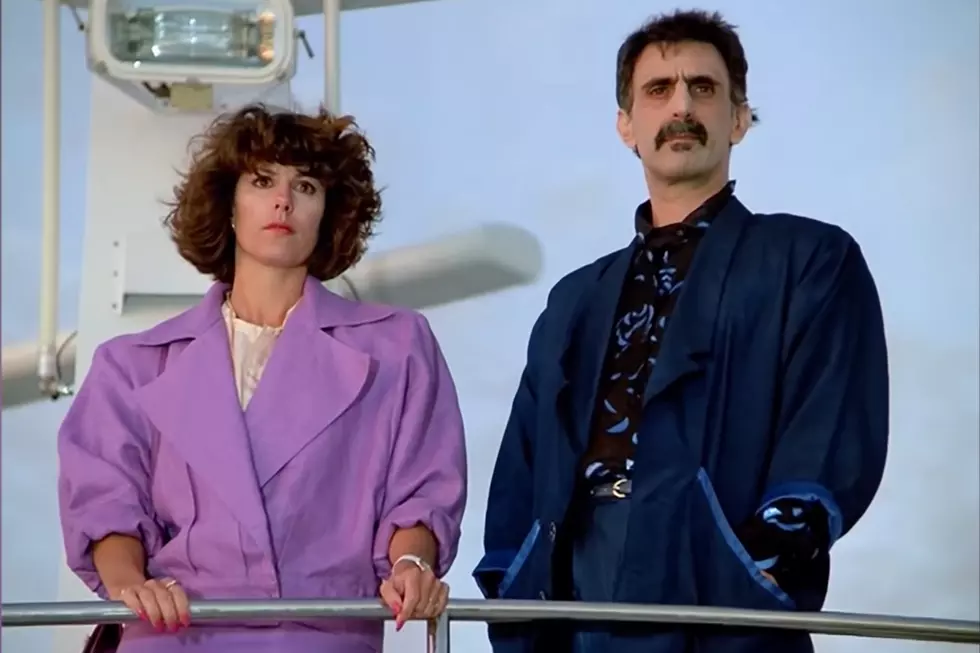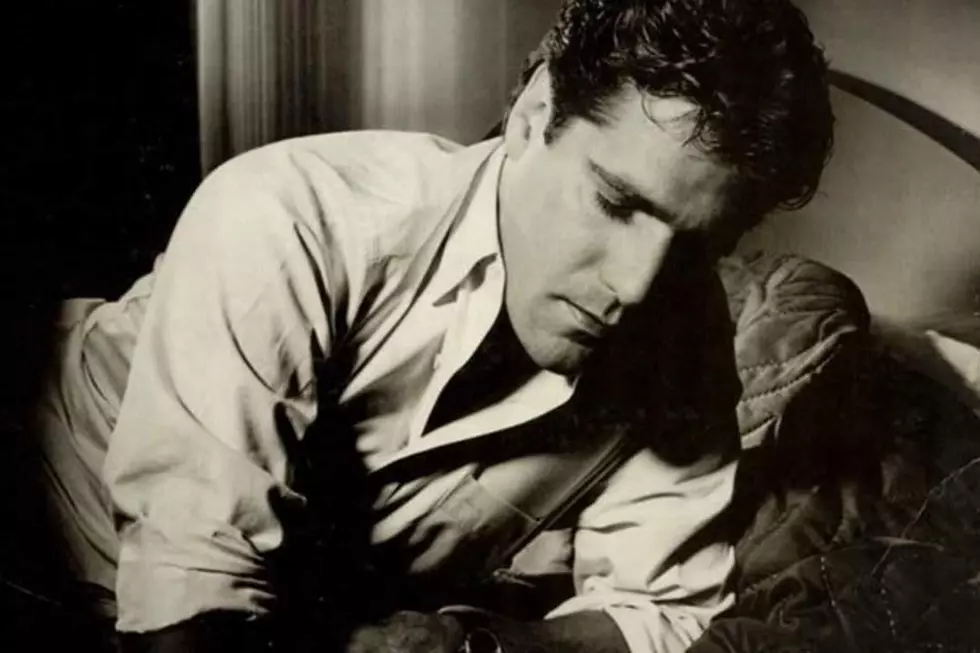
30 Years Ago: ‘Miami Vice’ Ends After Changing TV Forever
For a brief span in the '80s, there was nothing on television that could compare to Miami Vice.
The opening credits let you know you were in on something radically new: a synth-pop score (by Jan Hammer) hammered out at you over rapid-cut shots of a strange and beautiful art-deco city by the ocean. After this came a hyper-stylized show featuring a pair of impossibly cool and tormented detectives – Sonny Crockett (Don Johnson) and Rico Tubbs (Philip Michael Thomas) – chasing drug dealers while wearing t-shirts under Armani jackets and driving Ferraris and cigarette boats. Everything these detectives encountered was beautiful and sordid, wryly comedic and yet also existential grandiose (particularly in the final seasons); it was a perfect depiction of the glittering coked-up underside of the pastel popped-collar Reagan decade.
Debuting in September 1984, by the end of its second season it was a pop culture phenomenon and the No. 9-rated show in the U.S. But Miami Vice wound up burning bright but fast, quickly dropping out of the Top 30, and its fifth season was promoted as its last.
The year began with Crockett, suffering the effects of a concussion, setting out to take over a Miami drug empire, Scarface-style. Eventually, Crockett returned to his senses, and he and Tubbs journeyed to Central America to smuggle out a dictator (Ian McShane) who wants to turn informant to the DEA but is prevented from leaving the country by the drug cartels. A two-hour finale broadcast on May 21, 1989 called "Freefall" in which Crockett and Tubbs turned in their badges.
However, there were four episodes that remained in NBC's vault. Three of them were aired on NBC a month later, but the network refused to show the fourth, "Too Little, Too Late," due to a plot that involved child molestation. Instead, it was sent to the USA Network, which been airing reruns of Miami Vice for the previous two years. It was shown on Jan. 25, 1990, leaving behind an entertainment world that would never be the same.
The show was the brainchild of Anthony Yerkovich, a writer and producer who cut his teeth on standard fare like Starsky and Hutch, Hart to Hart, and Fantasy Island before moving on to a long stint on Hill Street Blues. The gritty realism of the latter certainly influenced Miami Vice, but it seems fair to say that the primary shaper behind the show was not Yerkovich but executive producer Michael Mann.
Mann, who'd also written on Starsky and Hutch, had scored a major success with his 1981 directorial debut Thief, starring James Caan. Working in the gritty '60s and '70s crime story tradition of filmmakers like Arthur Penn, John Boorman and William Friedkin, the film established him as a director interested in using realism to explore metaphysical themes that, in the hands of another director, might easily become overwrought. (It's no coincidence that two of Mann's later successes, The Insider and Heat starred Al Pacino, an actor with a similar affinity for a kind of too-large authenticity.)
It was this signature cinematic style that Mann brought to the set of Miami Vice, instilling in the show a mix of romance and terror encapsulated in an instantly recognizable aesthetic. He forbade his directors from showing anything in earth tones, and the color red was in particular never to appear.
He also brought this approach to the show's setting. Much of it was filmed Miami's South Beach neighborhood, then decrepit and practically deserted. Mann and his production designers – initially attracted by the ease of filming there – made the decision to highlight the distinctive architecture of the area, in the process creating an image as much as finding one.
In the Miami Herald, Andres Viglucci wrote that the show "not only helped save South Beach, broadcasting the architectural charms of its long-neglected Deco hotels and apartment houses to millions around the globe at a time when city fathers wanted nothing more than to tear it all down for condos, Miami Vice practically invented the idea of South Beach."
Equally as influential was the show's effect on the fashion world. The distinctive '80s look of a t-shirt worn under a sport coat with sockless loafers was popularized by Don Johnson's outfits, and his trademark Ray-Ban sunglasses became a required article of clothing for many men. These clothing choices were another aspect of the show's commitment to cool, and came from the producer's commitment to importing European fashion trends into the make-believe Miami they were creating. Gianni Versace, Hugo Boss and other designers were regularly consulted for wardrobe decisions; Kenneth Cole released "Crockett" and "Tubbs" shoe lines, and Macy's stores opened "Miami Vice" sections in their men's departments.
Like any show of its magnitude, Miami Vice also served as a launching pad for a huge number of actors who would go on to success. Edward James Olmos was already well-established as a character actor in film and TV, but it was his portrayal of Crockett and Tubbs' tough lieutenant with a hidden heart of gold – who showed his authority by habitually looking anywhere but directly at the person he was addressing – that allowed him to start taking on larger roles. The list of other actors who show up in episodes early in their career includes Jimmy Smits, Dennis Farina, Liam Neeson, Bill Paxton, Stanley Tucci, Ben Stiller, Ving Rhames, Oliver Platt, Melanie Griffith, Bruce Willis and many more.
But maybe the most lasting element of the show's influence was its commitment to pop music. Directly influenced by the launch of MTV in 1981, Miami Vice's use of music was not without precedent in the film world. The score by the German band Tangerine Dream, from Tom Cruise's 1983 breakthrough Risky Business certainly stands as a precedent (the band also scored Mann's Thief). In the same way, the beautifully weird dance scene in Brian DePalma's 1984 film Body Double – set to Frankie Goes to Hollywood's "Relax" – shows that many people were starting to think along the same lines in Hollywood.
But what Miami Vice brought to the party was the depth of the integration of the music into the fabric of the show. Virtually every episode featured sequences set to edgy songs by artists ranging from Duran Duran to Dire Straits to the Alan Parsons Project; the snarling nighttime city street montage in the pilot featuring Phil Collins' "In the Air Tonight" is one of the most memorable sequences of its kind ever created.
A number of musicians, including Collins himself, Miles Davis and Frank Zappa had guest appearances on the show, and Sheena Easton had a substantive role in Season Four as Don Johnson's love interest. This musical emphasis was so popular that the soundtrack, released in 1985 after the first season, stayed at the top of the charts for 11 weeks; this was a record for a TV soundtrack that remained standing until 2006, when it was beaten by High School Musical.
Perhaps more importantly, though, by 1989 Miami Vice had run out of time. Seinfeld, the show about nothing, had already begun to air. The Wonder Years was approaching its second season and Beverly Hills 90210 is set to appear the following fall. Nirvana was in the studio recording Bleach. The '90s was on the horizon, and little of the '80s world represented by Michael Mann was able to survive the onslaught of irony, indie film and flannel shirts that followed.
However, Man revived the characters for a movie in 2006, with Colin Farrell and Jamie Foxx as Crockett and Tubbs. It was a minor success, taking in $163 million worldwide against a budget of $135 million.
Johnson has since gone on to a long career, starring as the title role in TV's Nash Bridges and regularly appearing in films, with high-profile roles in Django Unchained and Knives Out. Thomas hasn't fared as well, and outside of Miami Vice, he's probably best remembered for coining the term EGOT, a reference to winning the Emmy, Grammy, Oscar and Tony Awards that he said was his life's ambition.
But in innumerable other ways, from the renaissance of South Beach to the ubiquitous use of moody popular music montages in everything from The Guardians of the Galaxy to The Witcher, the influence of Miami Vice lives on. In light of this, it's worth taking a peak back at it every once in a while, if only to remember one of the places our world came from.
18 Rock Stars Who Appeared on 'Miami Vice'
More From Ultimate Classic Rock









